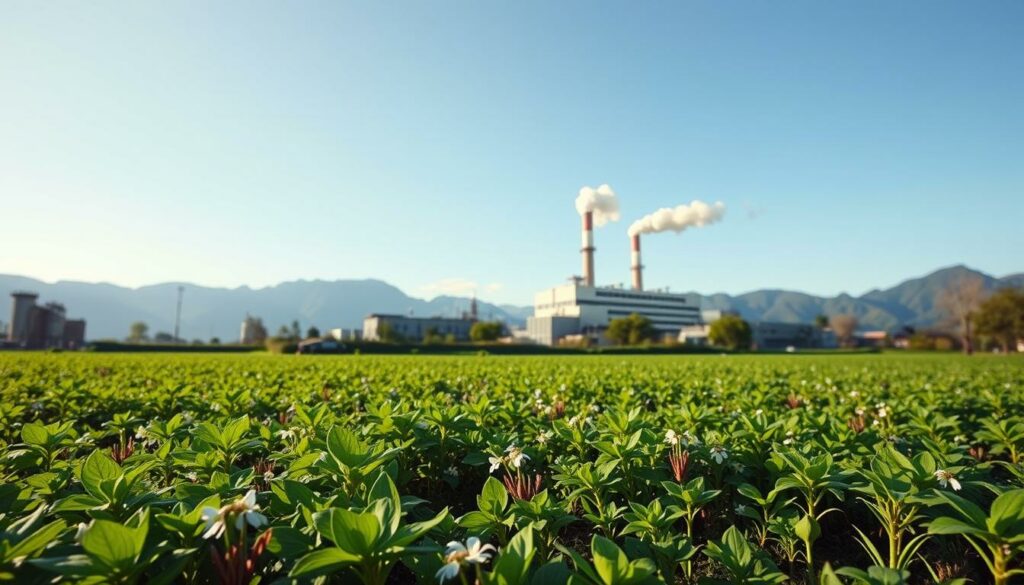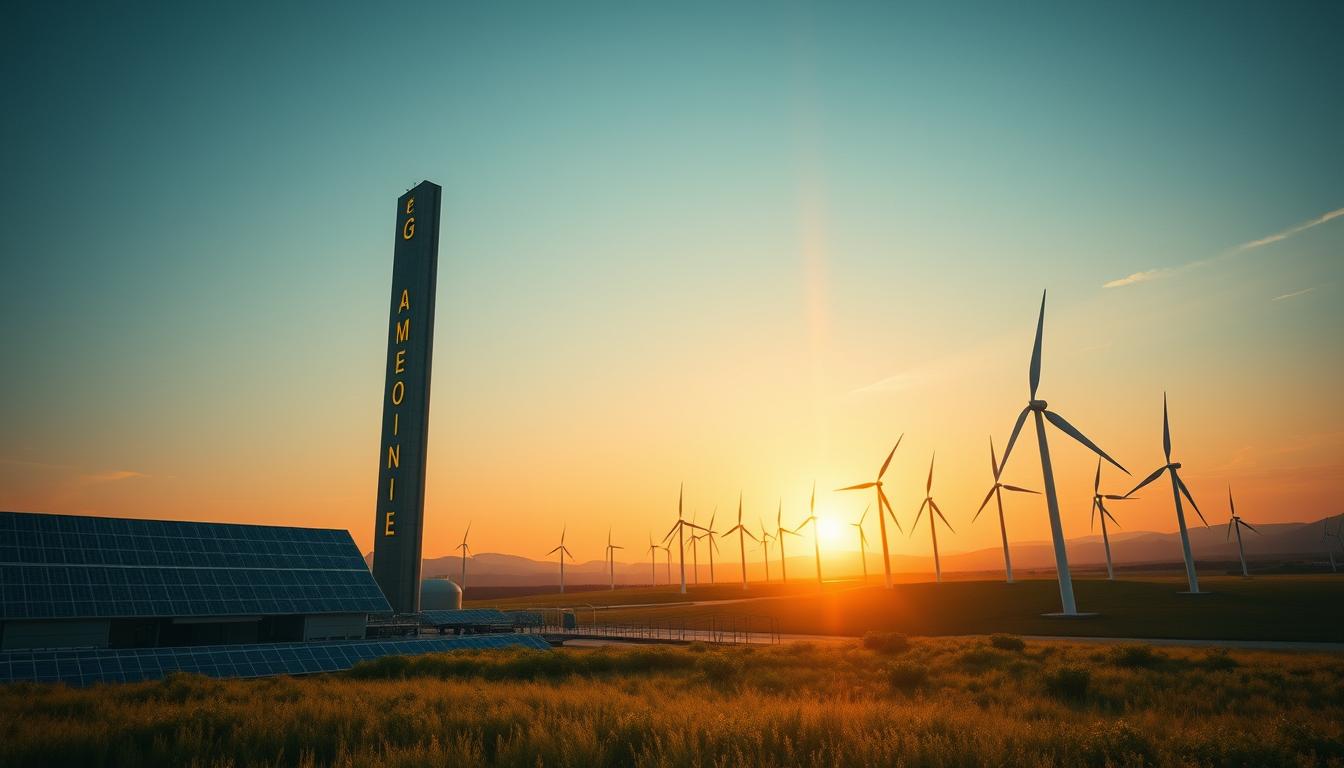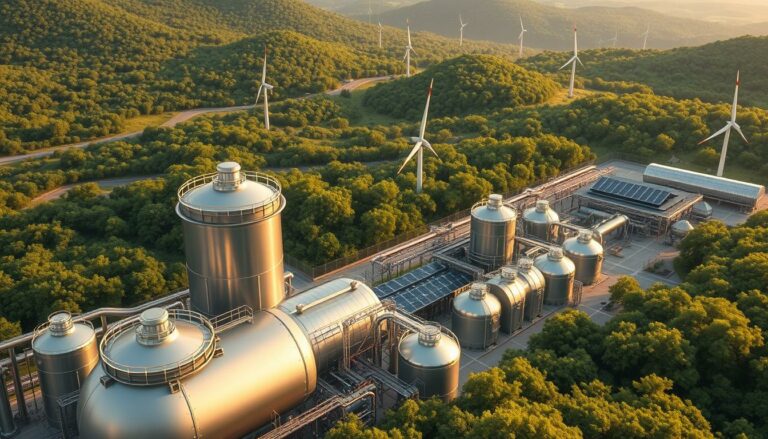Imagine a world where farming could cut its carbon footprint by 90 percent. That’s the power of green ammonia. It’s a new, green way to make ammonia that could change how we farm and move goods.
The farming world is on the verge of a big change. Green ammonia is a new way to make energy that could cut carbon emissions a lot. It lets us keep important industrial processes going while being kinder to the planet.
Right now, making ammonia worldwide creates almost 2 percent of all carbon emissions. Switching to green ammonia could change how we use energy and farm. It’s a big step towards a cleaner, greener future.
Key Takeaways
- Green ammonia can reduce farming’s carbon footprint by up to 90 percent
- Sustainable energy solutions are critical for global environmental goals
- The technology offers a carbon-free alternative to traditional ammonia production
- Agricultural and industrial sectors can significantly benefit from this innovation
- Renewable energy plays a key role in green ammonia production
Understanding the Fundamentals of Green Ammonia Production
Green ammonia is a new way to make chemicals that’s good for the planet. It uses clean energy to make important compounds without harming the environment.
The making of green ammonia is a big change from old methods. It uses two key things: electrolysis and clean energy.
The Chemistry of Green Ammonia Synthesis
To understand green ammonia, let’s look at its basic chemistry. Here’s how it’s made:
- Water is split into hydrogen and oxygen using electrolysis
- Nitrogen is taken from the air
- Hydrogen and nitrogen are mixed carefully
Comparing Production Methods
Old ways of making ammonia pollute a lot. Green ammonia is a cleaner choice:
| Traditional Method | Green Ammonia Method |
|---|---|
| Uses fossil fuels | Uses renewable energy |
| High CO2 emissions | Minimal carbon footprint |
| Expensive hydrogen production | Clean hydrogen through electrolysis |
Renewable Energy’s Critical Role
Using clean energy like wind and solar changes ammonia making. It cuts down on harmful emissions and makes industry greener.
Green ammonia production isn’t just a technological innovation—it’s a pathway to a cleaner, more sustainable future.
Green ammonia systems can be big or small, making lots of ammonia. The market could grow from 16.5 million tons to 200 million tons by 2050. This shows a big move towards making chemicals in a green way.
Environmental Impact and Carbon Footprint Reduction

The global ammonia industry is at a key moment to tackle greenhouse gas emissions. Traditional methods of making ammonia have been a big source of carbon pollution. They are responsible for about 2% of global carbon dioxide emissions. Conventional production methods release between 1.9 and 2.6 metric tons of carbon dioxide for every metric ton of ammonia made.
Big environmental issues in making ammonia include:
- Annual global production of ‘brown’ ammonia exceeds 175 million metric tonnes
- Approximately 450 million metric tons of CO2 emissions from ammonia production in 2020
- Potential for significant carbon neutrality through green ammonia technologies
Green ammonia is a game-changer for sustainable agriculture and industry. It uses renewable energy instead of fossil fuels. This could cut carbon emissions by up to 315 million tons of CO2. It also gives farmers a green fertilizer option, greatly reducing their carbon footprint.
The transition to green ammonia represents a critical strategy in our global effort to mitigate climate change and promote sustainable industrial practices.
New projects around the world show green ammonia’s power to lessen environmental harm. For example, the Asian Renewable Energy Hub project plans to make nearly 10 million tonnes of green ammonia yearly. The NEOM project in Saudi Arabia aims for a 4 GW solar setup for green ammonia.
Green Ammonia: The Revolutionary Clean Energy Solution
The world’s energy scene is changing fast, with green ammonia leading the way. It’s a clean fuel that could change how we store energy. People all over are taking notice, from scientists to government leaders.
Green ammonia is a big step forward in clean energy. It has great benefits for many areas. It’s a top choice for storing energy in a way that’s good for our planet.
Benefits of Green Ammonia as a Sustainable Fuel
- Reduces carbon emissions by up to 90% compared to old ways
- Provides zero ozone depletion
- Works well in power, shipping, and industry
- Keeps renewable energy safe for a long time
Storage and Transportation Advantages
Green ammonia has a big plus: it uses existing infrastructure. This makes it easy to move and store, giving it a big advantage.
| Market Projection | Value | Year |
|---|---|---|
| Green Ammonia Market Size | $41.4 billion | 2032 |
| Compound Annual Growth Rate | 72.9% | 2024-2032 |
| European Market Share | 45% | 2023 |
Economic Viability and Market Potential
The future of green ammonia looks bright. It’s getting cheaper and more people are investing in it. By 2024, it’s expected to be worth $5.2 billion, showing its strong growth.
Green ammonia isn’t just a theoretical concept—it’s a practical, scalable solution for our sustainable energy future.
Transforming Agricultural Practices with Green Fertilizers

The way we farm is changing fast, thanks to green ammonia. This new solution is making farming better for the planet. Before, making fertilizers was bad for the environment, but green ammonia is different.
Green ammonia brings many benefits to farming:
- It cuts down on carbon emissions a lot.
- It can help crops grow better.
- It’s made without any carbon emissions.
- It’s better for the planet.
“Green ammonia represents the future of agriculture – clean, efficient, and environmentally responsible.” – Agricultural Innovation Expert
Studies show green fertilizers could be a big deal. They use clean energy, which could cut down greenhouse gas emissions by 90% for some crops. This is a big step forward for farming that’s good for the planet.
| Metric | Traditional Fertilizer | Green Ammonia Fertilizer |
|---|---|---|
| Carbon Emissions | High (1.9-2.6 tons CO2/ton) | Near Zero |
| Production Cost | Lower | Currently Higher |
| Environmental Impact | Significant Negative | Minimal |
Green ammonia is getting attention worldwide. Big projects like BHP’s Jansen Project in Canada are investing in it. With a $10.6 billion investment, it shows a big push for better farming.
Looking ahead, green ammonia could change farming for the better. It gives farmers a chance to grow more food while being kinder to the environment.
Industrial Applications and Market Opportunities
Green ammonia is changing many industries, making energy cleaner and reducing carbon emissions. It’s becoming a key fuel for ships and a green energy source for factories.
The green ammonia market is growing fast, expected to hit USD 44,299.43 million by 2032. This shows its wide use in different fields.
Shipping and Maritime Transformation
Shipping is turning to green ammonia to cut down on emissions. The industry, which emits 3% of global carbon, sees green ammonia as a key clean energy option.
- Expected to make up 25% of shipping fuel by 2050
- Is a carbon-neutral choice for ships
- Helps meet global decarbonization goals
Power Generation Innovations
Power plants are looking at green ammonia for storing and making renewable energy. It’s a big help in making industries cleaner.
- Makes electricity without carbon emissions
- Is a stable and easy-to-store energy option
- Works well with current power systems
Manufacturing and Industrial Integration
Manufacturers see green ammonia as a game-changer for making things more sustainably. It’s not just for energy but also for making products.
Green ammonia is a key technology for making industries more sustainable.
With a 79.71% CAGR growth rate, green ammonia is set to change how industries use energy. It opens up new chances for green innovation.
Global Projects and Development Initiatives
The green ammonia revolution is changing how we think about energy worldwide. Countries are working together on green energy projects. These projects are happening in Europe, Asia, and the Americas, showing a big shift towards clean energy.
Important projects are starting up in key places around the world:
- Norway: Yara International launched its first green ammonia plant, marking a significant milestone in sustainable industrial practices
- United States: CF Industries is developing a flagship green ammonia facility in Louisiana
- Peru: The ‘Horizonte de Verano’ project aims to produce 1.65 million tons of green ammonia annually by 2032
- India: Planning to produce five million tons of green hydrogen by 2030
The market for green ammonia is huge. The Green Ammonia Market is projected to reach USD 41.4 billion by 2032, with an impressive compound annual growth rate of 72.9%. This shows how much the world wants to move towards clean energy.
“Green ammonia represents a transformative technology that can significantly reduce carbon emissions across multiple industries.” – Energy Innovation Expert
Europe is leading with about 45% of the green ammonia market. But Asia Pacific is growing fast. Governments are helping by giving incentives and setting goals to fight climate change.
These efforts show we’re all working together to save our planet.
Technology Innovations in Green Ammonia Production
The world of green ammonia production is changing fast. New innovative technologies are making sustainable chemical making better. Scientists and engineers are working hard to make production more efficient and eco-friendly. They are using green chemistry to achieve this.
Scientists are leading the way with new ideas. They want to make production better and cut down on harm to the environment. Here are some key innovations changing the green ammonia world:
- Advanced electrolysis systems that use less energy
- New catalysts that work better
- Technologies to make the process more efficient
Advanced Electrolysis Systems
Scientists are creating new electrolysis tech that needs less energy. For example, new methods work at lower pressures than old ways. RMIT University found a way to use 20% less heat and 98% less pressure.
Next-Generation Catalysts
New catalyst research is a big deal for green ammonia. Mixing copper and gallium makes better catalysts than using just one metal. These new catalysts can make 1 kg of pure ammonia daily. They work at just 50 bar, a big step up from before.
Process Optimization Technologies
There’s also a push for better process tech. Researchers are looking at modular systems that can fit in shipping containers. This could cut down on emissions from moving stuff around. It makes green ammonia production more flexible and easy to get to.
| Technology Aspect | Traditional Method | New Innovative Approach |
|---|---|---|
| Operational Pressure | Over 150 bar | 50 bar |
| Temperature | Exceeding 400℃ | Significantly reduced |
| Production Efficiency | High energy consumption | 15% possible cost cut |
Economic Challenges and Investment Landscape
The green ammonia sector faces big challenges that make it hard to adopt widely. Traditional ammonia production is much cheaper. But, new green investments are changing the game.
Cost is the main problem for green ammonia. Studies show that making ammonia from fossil fuels is about 73% cheaper than making it electrically. But, new tech is closing this gap.
“The future of green ammonia lies not in its current cost, but in its huge sustainable transformation.”
Big economic hurdles include:
- High initial capital investments
- Complex infrastructure development
- Limited technological maturity
- Competitive pricing pressures
Investment trends show good signs:
| Investment Area | Potential Impact |
|---|---|
| Renewable Energy Integration | Reducing production costs by up to 45% |
| Advanced Production Technologies | Improving energy efficiency |
| Government Incentives | Supporting green ammonia projects |
The green ammonia sector is on the move. With more research, policy help, and new tech, barriers are falling. This makes green investments more appealing.
Policy Framework and Government Support
The world is moving towards green ammonia, thanks to smart policies and government help. As we look for cleaner energy, leaders are making plans to speed up green ammonia use.
Across the globe, governments see green ammonia as a game-changer. They’re setting up new ways to support it. The way we pay for carbon is changing, making green tech more appealing.
International Regulatory Landscape
Rules from around the world are key to growing green ammonia. The main areas of focus are:
- Setting clear goals to cut emissions
- Creating rules for green products
- Working together across borders
Investment Incentives
Government help is vital to grow green ammonia. Today, we see:
- Direct help for making green hydrogen
- Breaks on taxes for green energy
- Grants for research and development
Carbon Pricing Impact
How we pay for carbon is changing the game for green ammonia. The EU’s big plans to cut emissions show how rules can push tech forward. By 2030, the EU wants to cut emissions by at least 40% from 1990 levels. This will help green tech thrive.
Transformative policy frameworks are essential for accelerating green ammonia’s global adoption.
Green ammonia costs between $720 and $1,400 per ton today. But, with government support, it could become affordable for businesses.
Conclusion
The future of green ammonia looks bright, promising a big change in our energy use. Right now, we make 192 million tons of ammonia every year. By 2050, we might make 200 million tons, thanks to sustainable innovation.
This change could cut down a lot on greenhouse gas emissions. It’s good for shipping and farming, too.
To make green ammonia work, we need new ideas. Making it costs more than traditional methods. But, countries like Japan are setting big goals. They want to use 3 million tons by 2025 and 30 million tons by 2030 for power.
Working together is essential. Governments, scientists, and companies must team up. Green ammonia burns clean and has more energy than hydrogen.
As we move forward, green ammonia will be key. It will help us switch to cleaner energy. This is just the start of a big change in how we use energy and farm.


